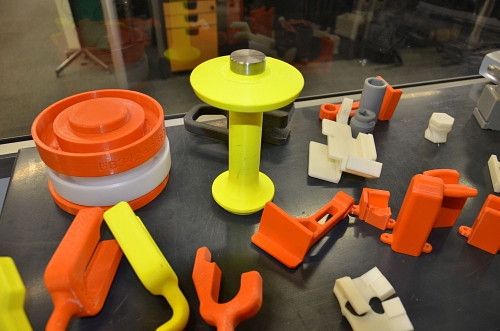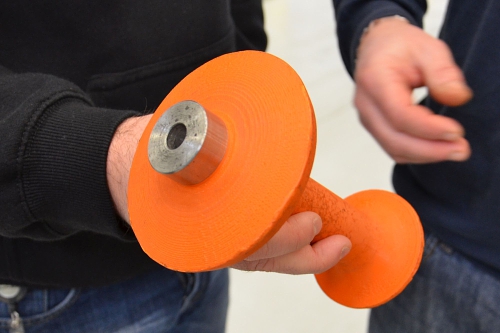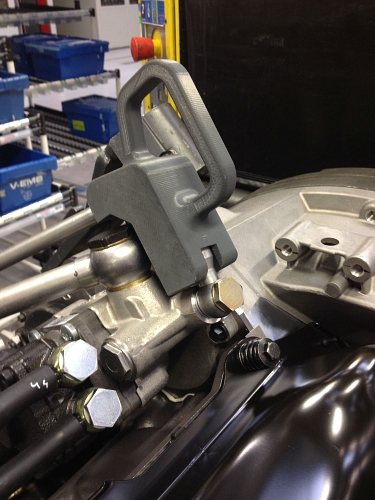 |
| April 21, 2015 | Volume 11 Issue 15 |
Designfax weekly eMagazine
Archives
Partners
Manufacturing Center
Product Spotlight
Modern Applications News
Metalworking Ideas For
Today's Job Shops
Tooling and Production
Strategies for large
metalworking plants
Wheels:
Volvo Trucks slashes manufacturing tool production time 94% with 3D printing

These clamps, jigs, and supports were made inexpensively by Volvo Trucks using Stratasys additive manufacturing technology.
Using Stratasys additive manufacturing technology, Volvo Trucks has reduced turnaround times on certain clamps, jigs, and supports from 36 days to just two days.
Volvo Trucks is dramatically decreasing turnaround times of assembly line manufacturing tools by more than 94 percent since incorporating Stratasys additive manufacturing technology at its engine production facility in Lyon, France.
Volvo Trucks' Lyon engine plant produces various engine types and sizes for the Volvo Group, including Renault Trucks, which the Group bought in 2001.
According to Pierre Jenny, manufacturing director at Volvo Trucks, the company has reduced the time taken to design and manufacture certain tools traditionally produced in metal, from 36 days to just two days in thermoplastic ABSplus using its Stratasys Fortus 3D Production System. These significant gains in time are also improving the production plant's overall efficiency and flexibility; delivery times are upheld and the use of additive manufacturing has saved costs by reducing wastage.

Assembly-line tools produced by Volvo Trucks with Stratasys' FDM 3D-printing technology include this durable, yet lightweight punching tool.
From a financial perspective, Jenny estimates that, where customized or small quantities of tools are required, the all-in cost of 3D printing ABS thermoplastic items is -- in some cases -- as little as 1 euro/cm3 compared to up to 100 euro/cm3 if making the same item from metal*.
"Stratasys 3D printing has made an incredible impact to the way we work," he says. "The capability to produce a virtually unlimited range of functional tools in such a short timeframe is unprecedented and enables us to be more experimental and inventive to improve production workflow."
Volvo Trucks purchased its Fortus 3D Production System from Stratasys' reseller CADvision and, within a three-month period, had already 3D printed more than 30 different production tools to facilitate the way its production line operators worked. These include a range of different durable yet lightweight clamps, jigs, supports, and even ergonomically designed tool holders that ensure a more organized working environment for operators.
"We're working in the heavy-industry sector, so reliability is naturally critical. So far, every piece that we have 3D printed has proved to be 100 percent fit-for-purpose," says Jean-Marc Robin, technical manager, Volvo Trucks. "This is crucial from a practical aspect, but also instills trust among operators and quashes any traditional notion that everything has to be made from metal in order to function properly."
According to Robin, developing production tools using additive manufacturing also enables the equipment design team to be far more responsive while avoiding possible wastage in the event of last-minute design changes before tools are made.

This Stratasys 3D-printed hose holder (in gray) is used to maintain the position of an engine hose during engine assembly by the production line operator.
"The fast and cost-effective nature of additive manufacturing means that we are far less restricted than we were even six months ago, allowing us to constantly improve our processes," Robin says. "We now have operators approaching our 3D-print team with individual requests to develop a custom clamp or support tool to assist with a specific production-line issue they might be having. From a time and cost perspective, this is unimaginable with traditional techniques.
"Additionally, in the rare case that the design specifications of a traditionally manufactured metal tool were inaccurate, the lengthy and costly design and manufacturing process had to begin again. With a 3D-printed part, we can simply alter the design specifications and re-3D print the piece in a few hours," Robin adds.
"More and more of our customers are adopting additive manufacturing as the first phase to produce jigs and fixtures," says Andy Middleton, Senior VP and general manager, Stratasys EMEA.
"As exemplified at Volvo Trucks, using additive manufacturing for tooling and work-holding devices is a reliable solution for increasing efficiency in manufacturing processes. In many cases, it is also the only feasible solution as production by traditional method is limited due to cost or design constraints," says Middleton.
*1 euro/cm3 equivalent to $1.13 per 0.06 cubic in.; 100 euro/cm3 equivalent to $113 per 0.06 cubic in.
Source: Stratasys
Published April 2015
Rate this article
View our terms of use and privacy policy
